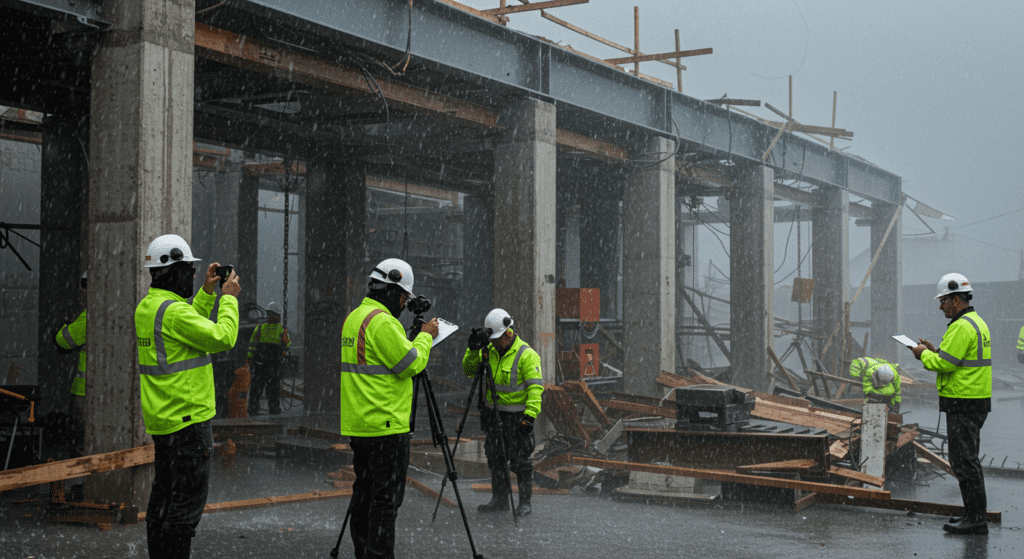- The Role of Documentation in Claims Success
- Timely Notification and Its Impact on Outcomes
- Case Study: Overcoming Storm Damage
- Case Study: Navigating Fire Related Losses
- Effective Communication with Insurers
- Lessons Learned from Successful Claims
- Best Practices for Construction Insurance
- Legal Considerations and Compliance
- Future Trends in Insurance Claims Success
Construction insurance claims play a critical role in ensuring the financial stability of projects and protecting businesses against unforeseen losses. With a variety of risks inherent to construction, from weather-related damages to accidents on site, having insurance is only the first step. The success of a claim depends on thorough preparation, proper documentation, and timely action when an incident occurs. The process may seem daunting, yet understanding its key components can make it substantially more manageable for construction professionals and project managers alike.

1. The Role of Documentation in Claims Success
Accurate and detailed documentation often makes the difference between a successful claim and a rejected request. Detailed reports, photos, blueprints, contracts, and maintenance logs are indispensable assets that build a compelling case for compensation. Every incident, no matter how minor, should be documented promptly. Information such as the type of damage, cause, location, and time stamp provide important data that can validate the circumstances leading to the claim. Additionally, records of past maintenance and repairs can support the argument that losses arise from covered causes and not from negligence.
2. Timely Notification and Its Impact on Outcomes
The value of prompt notification in construction insurance claims cannot be overstated. Most insurance policies have strict timelines for reporting an incident once it happens. Delays in notification can result in a denial of the claim, leaving a construction project vulnerable to significant financial loss. Early notification not only complies with policy requirements but also allows insurers to begin their investigations swiftly, potentially reducing further damage and associated repair costs. A proactive approach in alerting the insurance company demonstrates a commitment to cooperation and often expedites the entire claims process.

3. Case Study: Overcoming Storm Damage
Consider a project where a severe storm damages partially completed structures. The construction company acted immediately by notifying the insurer within hours of the event. With detailed photographs taken on-site, weather reports supporting the claim, and a complete inventory of damage, the claim was processed efficiently. The insurer was able to quickly verify the cause of the damage with independent meteorological data. The prompt action, combined with meticulous documentation, allowed the project to resume construction much faster than anticipated. This scenario underlines how a well-coordinated response following natural disasters can mitigate long-term project delays and financial strain.
4. Case Study: Navigating Fire-Related Losses
Another example involves a significant fire outbreak at a bustling construction site. In this case, the construction firm had established strong communication channels with the local fire department and emergency services. Immediate reporting combined with a robust set of fire safety records and maintenance logs made the aftermath far less chaotic. Insurance adjusters reviewed the documented preventive measures, which played a crucial role in supporting the claim. An independent safety audit was also conducted to further validate the company’s adherence to rigorous fire safety standards. The comprehensive groundwork and strategic communication ensured that claim funds were released in a timely manner, enabling a swift return to business operations.

5. Effective Communication with Insurers
Clear and open lines of communication with insurers are fundamental in managing claims. Regular updates, willingness to provide additional information, and understanding the insurer’s requirements all contribute to a smoother claims process. Project managers should designate a reliable representative who is well-versed in both the operational facets of construction and the intricacies of insurance policies. This person should act as a liaison, coordinating all data gathering and communication efforts. Transparency about the extent and specifics of the damage fosters trust between the claimants and insurers, and it cultivates an environment where negotiations can lead to favorable outcomes. Establishing such rapport early in the claim process is crucial when addressing any hurdles or disputes that may arise later.
6. Lessons Learned from Successful Claims
Several key lessons emerge from successful construction insurance claims. First, investing in robust documentation policies pays dividends when a claim needs to be filed, reducing the room for argument or misunderstanding. Second, a culture of proactive risk management and prevention is essential. Regular safety audits, prompt risk assessments, and continuous education for on-site personnel contribute to a well-maintained project environment that limits potential losses. Third, understanding the specifics of your insurance policy, including coverage nuances and claim procedures, should be a priority for any project manager. Equally important is the recognition that delays or miscommunication can jeopardize a claim, underscoring the need for swift and transparent reporting throughout the project lifecycle.
7. Best Practices for Construction Insurance
Adopting best practices ensures that the process of filing and managing construction insurance claims remains efficient. These practices include maintaining a comprehensive digital record of all activities related to construction, such as site logs, maintenance schedules, and inspection reports. Employing specialized software for tracking project milestones and damages can also enhance documentation efforts. Regular training sessions focused on claim protocols and emergency response strategies are essential for keeping teams prepared for unexpected events. Additionally, it is advisable to review and update policies periodically, ensuring that they are aligned with current regulations and market conditions. By implementing these proactive measures, construction companies not only improve risk management but also expedite claim settlements when the need arises.

8. Legal Considerations and Compliance
Legal factors and compliance issues are paramount in construction insurance claims. Construction companies must be aware of the legal framework governing insurance policies, contractual obligations, and local building codes. Staying compliant with regulatory requirements not only minimizes the risk of lawsuits but can also influence claim outcomes. Expert legal advice should be sought when drafting contracts and insurance policies to ensure that all potential risks are adequately covered. Moreover, an understanding of the appeals process for denied claims is vital. Legal representation may be required to navigate complex disputes between the insured and the insurer. Compliance with such legal protocols ensures that the construction company is shielded from further complications and can rely on the full support of their insurance policy in times of crisis.
9. Future Trends in Insurance Claims Success
The future of construction insurance claims is evolving rapidly with technological advancements and regulatory changes. The integration of drones, artificial intelligence (AI), and advanced analytics is transforming how damage is assessed and claims are processed. Drones can quickly capture high-resolution images of affected areas, while AI can analyze these images to detect patterns and estimate repair costs more accurately than traditional methods. Additionally, blockchain technology is beginning to play a role in ensuring the integrity and security of documentation, making it harder to dispute claims. As these technologies become more mainstream, construction companies that adopt them will likely experience smoother claim processes and faster settlements. Furthermore, the growing emphasis on sustainable building practices and climate resilience may prompt insurers to update their policies, addressing new types of risks associated with extreme weather events and environmental changes.
In this rapidly evolving landscape, it is crucial for stakeholders to remain adaptable. Keeping abreast of industry trends and investing in new technologies will not only safeguard construction projects but also enhance the overall credibility and efficiency of claims handling. Future advancements are poised to reduce turnaround times and improve the accuracy of claims assessments, ultimately benefitting both insurers and construction companies.

10. Conclusion
A strategic approach to construction insurance claims can significantly influence a project’s ability to recover from setbacks. By prioritizing detailed documentation, timely notification, effective communication, and legal compliance, construction companies can better navigate the complexities of insurance claims. Real-world case studies of both storm damage and fire-related losses illustrate that proactive measures and preparedness directly contribute to successful claim outcomes. Looking ahead, technology and evolving market dynamics promise to reshape the way claims processes are executed, making it imperative for industry professionals to remain vigilant and adaptable. Ultimately, a knowledgeable, well-prepared, and legally compliant approach positions construction businesses to handle unexpected incidents, ensuring that growth and progress remain uninterrupted.
